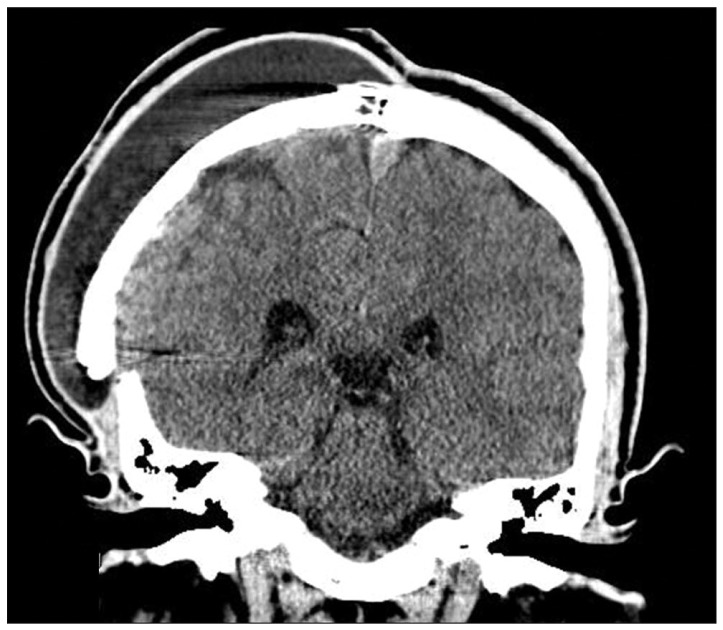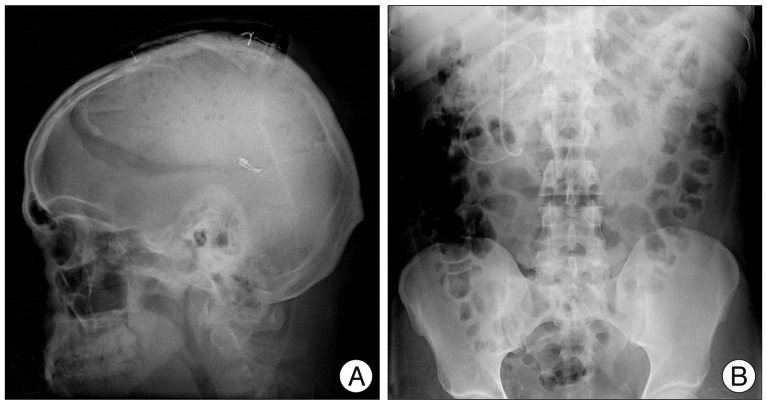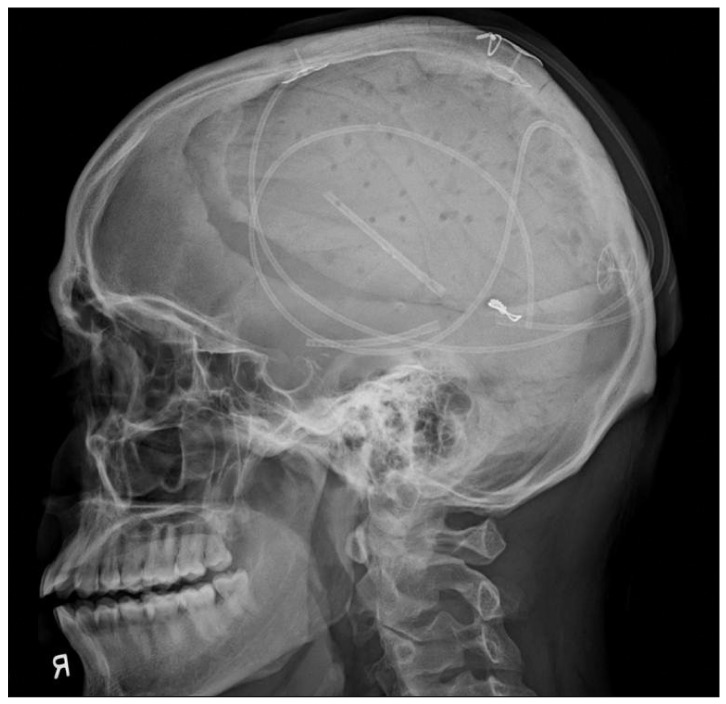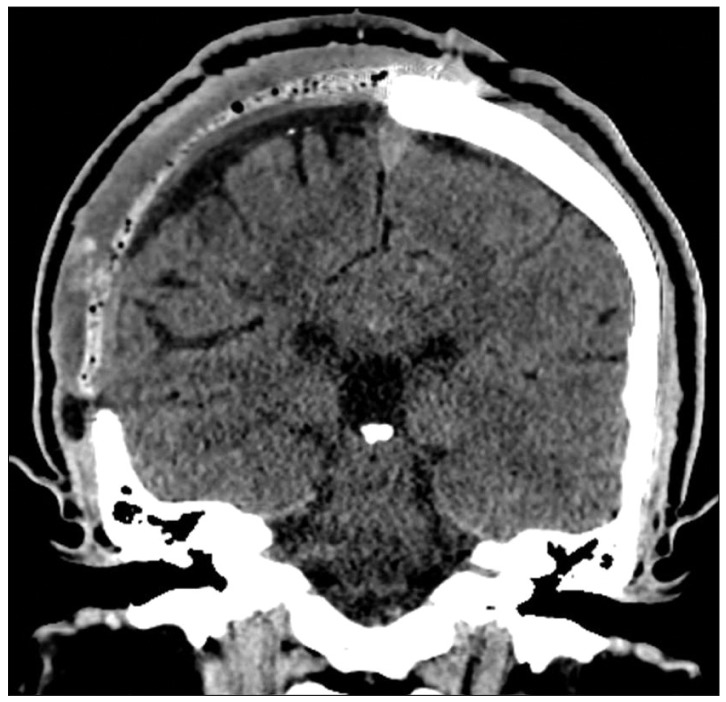J Korean Neurosurg Soc.
2013 Dec;54(6):525-527. 10.3340/jkns.2013.54.6.525.
Migration and Coiling of Peritoneal Catheter into the Subgaleal Space: A Very Rare Complication of Subgaleoperitoneal Shunt
- Affiliations
-
- 1Department of Neurosurgery, Gil Medical Center, Gachon University, Incheon, Korea. gtyee@gilhospital.com
- 2Department of Neurosurgery, Ilsan Paik Hospital, College of Medicine, Inje University, Goyang, Korea.
- KMID: 2190952
- DOI: http://doi.org/10.3340/jkns.2013.54.6.525
Abstract
- Upward migration of the peritoneal catheter of a subgaleo-peritoneal (SP) shunt and coiling into the subgaleal space is an extremely rare complication of a SP shunt. A 32-year-old male patient visited our hospital presenting with a large skull defect due to a prior craniectomy performed elsewhere. The patient underwent a cranioplasty with methylmetacrylate, but subsequently developed progressive pseudomeningocele and subgaleal cerebrospinal fluid (CSF) collection. The patient underwent CSF diversion via a SP shunt. After SP shunting, the pseudomeningocele disappeared completely. Six months later, the patient presented with progressive scalp swelling. Skull X-ray showed migration and coiling of the distal catheter of the SP shunt. The patient was treated by removing the entire shunt catheter and the dura was covered with a subgaleal flap. We would like to report our experience with a very rare complication of subgaleo-peritoneal shunting.
Figure
Reference
-
1. Acharya R, Bhutani A, Saxena H, Madan VS. Complete migration of ventriculoperitoneal shunt into the ventricle. Neurol Sci. 2002; 23:75–77. PMID: 12235495.
Article2. Agarwal A, Kakani A. Shunt malfunction due to proximal migration and subcutaneous coiling of a peritoneal catheter. J Neurosci Rural Pract. 2010; 1:120–121. PMID: 21808520.3. Jang HD, Kim MS, Lee NH, Kim SH. Anal Extrusion of Distal V-P Shunt Catheter after Double Perforation of Large Intestine. J Korean Neurosurg Soc. 2007; 42:232–234.4. Johnson MC, Maxwell MS. Delayed intrapleural migration of a ventriculoperitoneal shunt. Childs Nerv Syst. 1995; 11:348–350. PMID: 7671271.
Article5. Kiran NA, Thakar S, Mohan D, Aryan S, Rao AS, Hegde AS. Subgaleo-peritoneal shunt: an effective and safer alternative to lumboperitoneal shunt in the management of persistent or recurrent iatrogenic cranial pseudomeningoceles. Neurol India. 2013; 61:65–68. PMID: 23466843.
Article6. Oktem IS, Akdemir H, Koç K, Menkü A, Tucer B, Selçuklu A, et al. Migration of abdominal catheter of ventriculoperitoneal shunt into the scrotum. Acta Neurochir (Wien). 1998; 140:167–170. PMID: 10398996.
Article7. Pang D, Wilberger JE Jr. Upward migration of peritoneal tubing. Surg Neurol. 1980; 14:363–364. PMID: 7444744.8. Patel CD, Matloub H. Vaginal perforation as a complication of ventric uloperitoneal shunt. Case report. J Neurosurg. 1973; 38:761–762. PMID: 4710656.9. Shahsavaran S, Kermani HR, Keikhosravi E, Nejat F, El Khashab M. Ventriculoperitoneal shunt migration and coiling: a report of two cases. J Pediatr Neurosci. 2012; 7:114–116. PMID: 23248689.
Article10. Thipphavong S, Kellenberger CJ, Rutka JT, Manson DE. Hepatic and colonic perforation by an abandoned ventriculoperitoneal shunt. Pediatr Radiol. 2004; 34:750–752. PMID: 15164137.
Article
- Full Text Links
- Actions
-
Cited
- CITED
-
- Close
- Share
- Similar articles
-
- Upward Migration of a Peritoneal Catheter Following Ventriculoperitoneal Shunt
- Intrahepatic Migration of a Peritoneal Shunt Catheter: Case Report
- A Case of Migrated Peritoneal Catheter of V-P Shunt System into Right Ventricle: Case Report
- An Incidentally Detected Ventriculoperitoneal Shunt Catheter in the Scrotum
- Peranal Elimination of Peritoneal Catheter in an Adult with Ventriculoperitoneal Shunt Operation: Case Report





